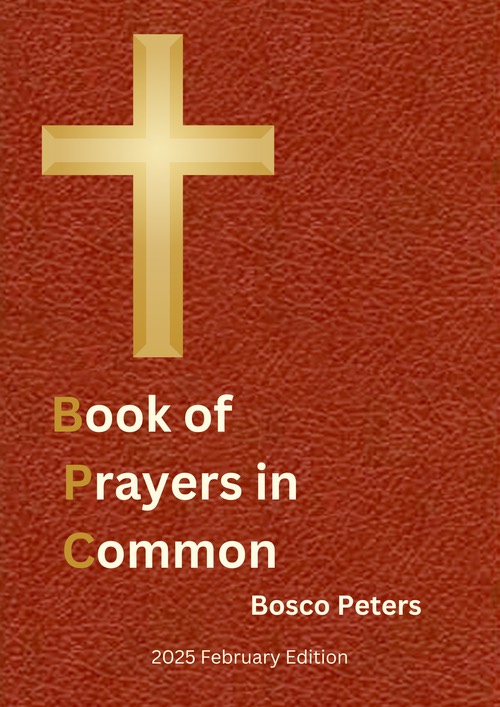
MARCH 24, 2025 UPDATE: I have, from feedback and my own observations, updated the Book of Prayers in Common. The March 2025 edition is now available free by clicking on the link in the previous sentence. A permanent Page for this resource is found here.
I am absolutely delighted that I have finally completed a full Sunday set of traditional collects reworked for our contemporary context.
The February edition is available as a pdf here.
This is still a draft – constructive comments gratefully received, either here on this post or written to liturgy DOT co DOT nz AT gmail DOT com
I think it was first in 2012 that I began to notice that Roman Catholics and Anglicans (following the Book of Common Prayer of the Episcopal Church) often prayed the same collect on the same day. I know of no one who had written about this previously. Nor has an explanation been given for this surprising (hidden?) ecumenical reality.
Thomas Cranmer had often drawn on the classic Latin collects (including through the Sarum rite) for his Book of Common Prayer. Twentieth Century Anglican liturgical revisions obviously looked back to that work. The post-Vatican II liturgy also drew from the same Latin resources. It, hence, seems unsurprising that the same collect was used by Roman Catholics and Anglicans on the same day in the great seasons of Advent, Christmas, Lent, and Easter. But I had never seen highlighted that Book of Common Prayer of the Episcopal Church often followed the same Latin collect on the same Sunday as Roman Catholics in the post-Vatican II newly-designed “Ordinary Time”. Furthermore, the Roman Catholic English translations (from ICEL 1973) were often so much more a paraphrase than the tighter Cranmer-style Anglican ones. When the new Roman Catholic English translations (from ICEL 2011) came along, the similarity to Anglican collects became more pronounced.
So, about twelve years ago, I began writing reflections on those shared collects. I also started producing my own rendering of collects, beginning from the Latin.
I know my resource will be used internationally and ecumenically, and that was a significant motivator for this significant amount of work. But my own particular context, of serving as a priest in NZ Anglicanism, has also provided a strong incentive. I am grateful for the encouragement local and international, within my own Church, and ecumenically. I hope that such wide feedback will improve what I have produced.
NZ Anglicanism had already abandoned some well-loved, well-worn collects in the 1989-2005 A New Zealand Prayer Book He Karakia Mihinare o Aotearoa. Then, in 2011, there was an attempt to publish a new edition of this Prayer Book without going through the “twice-round” formularies process. I advocated strongly against this, and those presses were stopped.
Following this, in 2012 I promoted a motion which was passed by General Synod te Hinota Whanui (GSTHW) “that in any revision of A New Zealand Prayer Book/He Karakia Mihinare o Aotearoa each Sunday and Holy Day be provided, in the text, with at least one collect which follows the taonga/treasure of Trinitarian collects (that is, addressed to God, the First Person of the Trinity, through Christ, in the Spirit)“.
News of the presses-stopped NZPBHKMA 2011 was available in time for action to be taken. That was not the case for a 2020 edition of NZPBHKMA. Not only did that not go through GSTHW, it (re)introduced male pronouns for God (the absence of such male pronouns was, rightly, something that New Zealand Anglicanism was rightly internationally, and ecumenically, admired for), it removed even more well-loved collects, and it flagrantly defied the ruling of GSTHW that Sundays and significant feasts each be provided with actual Trinitarian collects (not simply lovely little prayers).
When, last year, the 2020 and 2024 editions were brought before GSTHW to begin the process of agreeing to the significant new material becoming formularies (agreed doctrine and practice of our Church), GSTHW did not think these two new editions were good enough to proceed to such a level of agreement. Furthermore, as NZPBHKMA is listed as binding on us in our Constitution, but much in NZPBHKMA 2020 & 2024 is not at the level of formularies, GSTHW has begun the complex process of removing NZPBHKMA from the Constitution and replacing that with the formularies in NZPBHKMA. And if you want to know about what the formularies are within the bound book you are holding, good luck to you! Here is the official listing of that.
As well as in this Book of Prayers in Common including prayers that are shared ecumenically (rooted in a shared, ancient Western tradition), there are also some prayers particularly common across Anglicanism (and, as I explained above, removed from official NZ Anglican resources). Finally, there were a couple of places where neither of those “in common” were the case and I chose to draw on the currently most-used collect for that day.
I hope you appreciate the new Book of Prayers in Common, and feedback any improvements that can be made. May God richly bless you as we pray together – around the world and across denominations – prayers that have been part Christian worship life since the earliest centuries.
Do follow:
The Liturgy Facebook Page
The Liturgy Twitter Profile
The Liturgy Instagram
and/or sign up to a not-too-often email



Thanks for this. I have downloaded the book. I write a spiff each week on the Collect for our parish bulletin. Some times the present RC translation is so odd it clouds the meaning rather than illuminating it.
Thanks for the encouragement, Greg. I would be fascinated to see (some of) your spiffs – I cannot find any copy of your parish newsletter online. I also write something on the collect each week. Here’s this coming Sunday’s. & yes, the current RC translations can be far too English-as-it-has-never-been-spoken. Blessings.